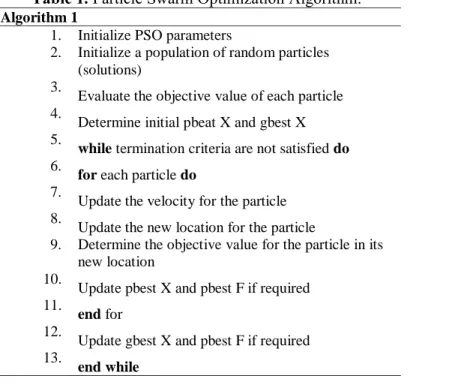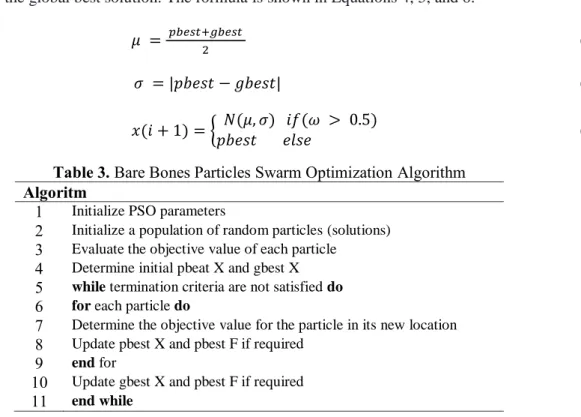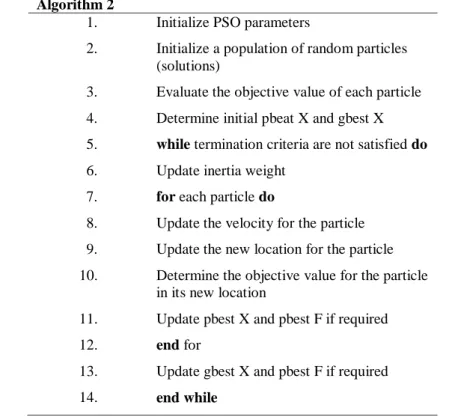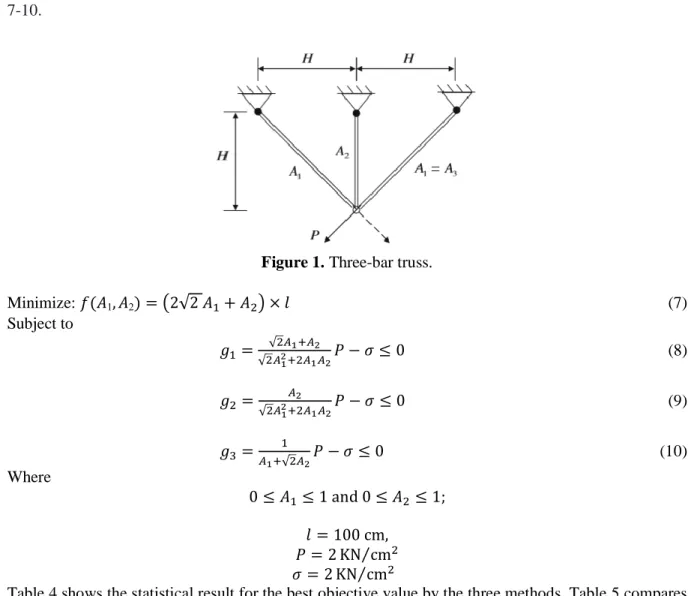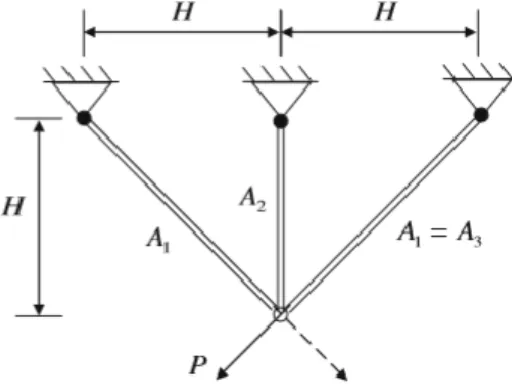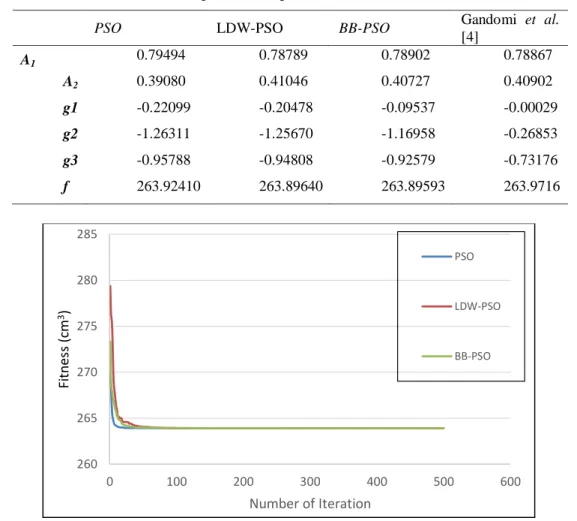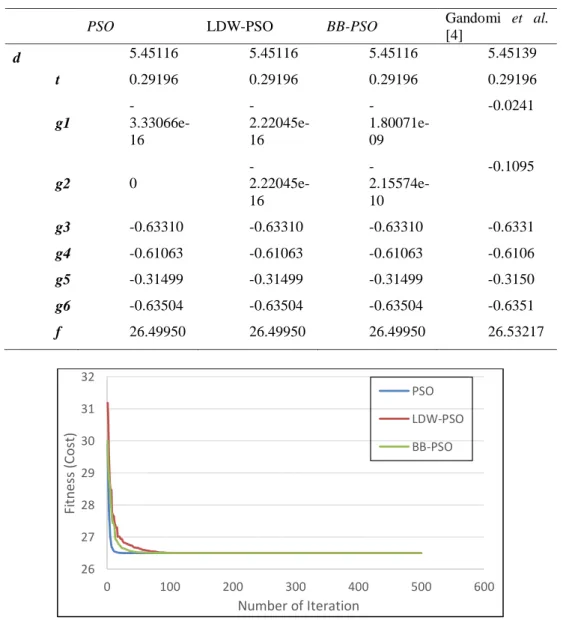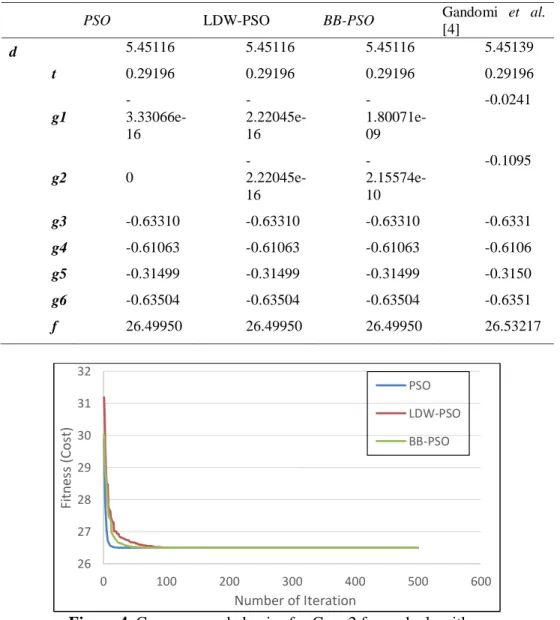IOP Conference Series: Earth and Environmental Science
PAPER • OPEN ACCESS
Structural Design Optimization Using Particle Swarm Optimization and Its Variants
To cite this article: D. Prayogo et al 2020 IOP Conf. Ser.: Earth Environ. Sci. 506 012048
View the article online for updates and enhancements.
This content was downloaded from IP address 114.124.135.71 on 18/08/2020 at 17:09
8/18/2020 IOP Conference Series: Earth and Environmental Science, Volume 506, 2020 - IOPscience
https://iopscience.iop.org/issue/1755-1315/506/1 1/6
Table of contents
Open all abstracts
Preface
Environmental Engineering
This site uses cookies. By continuing to use this site you agree to our use of cookies. To find out more, see our Privacy and Cookies
policy.
Volume 506 2020
Previous issue Next issue
Joint International Conference on Civil, Environmental, and Geo Engineering 2019 1-2 October 2019, Surabaya, Indonesia
Accepted papers received: 07 May 2020
Published online: 10 June 2020
011001 OPEN ACCESS
Preface
View article PDF Open abstract
011002 OPEN ACCESS
Peer review statement
View article PDF Open abstract
012001 OPEN ACCESS
Evaluation of Step Feeding Strategy in One-Stage Simultaneous Partial Nitritation, Anammox and Denitrification (SPNAD) Process
L C Direstiyani, J Kim, T Kwon, S Jeong, Y Kim, J Yu and T Lee View article PDF
Open abstract
012002 OPEN ACCESS
A Comparative Study of Life Cycle Impact Assessment using Different Software Programs
A P Iswara, A U Farahdiba, E N Nadhifatin, F Pirade, G Andhikaputra, I Muflihah and R BoedisantosoView article PDF Open abstract
012003 OPEN ACCESS
The treatment of Raw Water Sources of Drinking Water using Chitosan/Mg/Al–LDH Composites: Problem cases in Municipal Waterworks in Banjarmasin
C Irawan, M W Ramadhan, I F Nata and M D Putra View article PDF Open abstract
012004 OPEN ACCESS
Formulation of Attributes for Decision Support System for Drinking Water Infrastructure Developments Priority
K A Putra and U LasmintoView article PDF Open abstract
012005 OPEN ACCESS
Utilization of Hermetia illucens Larvae as A Bioconversion Agent to Reduce Organic Waste
N Fadhillah and A Y BagastyoView article PDF Open abstract
8/18/2020 IOP Conference Series: Earth and Environmental Science, Volume 506, 2020 - IOPscience
https://iopscience.iop.org/issue/1755-1315/506/1 2/6
012006 OPEN ACCESS
Adsorption of Fe ion from Aqueous Solution onto Rice Husk Biocomposite Magnetic Nanoparticle
I F Nata, A Mirwan, D R Wicakso, C Irawan, M D Isnaini and R Fitriani3+
View article PDF Open abstract
012007 OPEN ACCESS
The Azeotropic Distillation for Bioethanol Purification: The Effects of Entrainer Solvents
T Sriana, S Sakti, T Dianpalupidewi and A WahyudiView article PDF Open abstract
012008 OPEN ACCESS
The Effort to Increase Waste Reduction Through the Development of Waste Banks in South Surabaya
O M C Kesauliya and I D A A WarmadewanthiView article PDF Open abstract
012009 OPEN ACCESS
Aluminum and Organic Contaminant Removal from Drinking Water Treatment Sludge
R A Barakwan, A R Syavira and Y TrihadiningrumView article PDF Open abstract
012010 OPEN ACCESS
Microhydro with Tube: A Powerhouse Solution for Rural Elctricity
Purwanto, Budiono, Hermawan and SudarnoView article PDF Open abstract
012011 OPEN ACCESS
Toxicity Effects of Organic Substances on Nitrification Efficiency
W N Rochmah and S MangkoedihardjoView article PDF Open abstract
012012 OPEN ACCESS
Wet Scrubber for Coal Combustion with The Use of Textile Wastewater Feeding
HS Huboyo, Sudarno and LN PrassantyView article PDF Open abstract
012013 OPEN ACCESS
The Effect of Mixing Rate on Struvite Recovery from The Fertilizer Industry
Warmadewanthi, A Rodlia, N Ikhlas, E S Pandebesie, A Y Bagastyo and W HerumurtiView article PDF Open abstract
012014 OPEN ACCESS
Potential of Low Cost Sensor Usage for Waste Water IOT System
A S Telaga, E A Goffar and W SarfatView article PDF Open abstract
012015 OPEN ACCESS
Effects of Organic Substance on Denitrification Efficiency
S N Kholida and S MangkoedihardjoView article PDF Open abstract
012016 OPEN ACCESS
Effect of Rotation Speed on Phosphate and Nitrate Removal from Domestic Wastewater in The Oxidation Ditch
E N Hidayah, A U Farahdiba, D W Zara and F RosariawariView article PDF Open abstract
8/18/2020 IOP Conference Series: Earth and Environmental Science, Volume 506, 2020 - IOPscience
https://iopscience.iop.org/issue/1755-1315/506/1 3/6
012017 OPEN ACCESS
Study of Phasing Plan of Kalimati Water Treatment Plant Installation in Sidoarjo
S Firdaus and A PurnomoView article PDF Open abstract
012018 OPEN ACCESS
Evaluation of Zona Air Minum Prima (ZAMP) Program in Ngagel Tirto Surabaya
D Erianik, B D Marsono and E S SoedjonoView article PDF Open abstract
012019 OPEN ACCESS
Planning of the Main Distribution Network of the Prambon Subdistrict Region in 2032
G N F Nugroho, A Purnomo, S Firdaus, B D Marsono and R SumarsonoView article PDF Open abstract
012020 OPEN ACCESS
Impact of Additional Water Capacity from Umbulan Spring to Water Distribution System of Central Gresik and South Gresik
R F A Tarigan and A Purnomo
View article PDF Open abstract
012021 OPEN ACCESS
Design of Sewerage System and Wastewater Treatment Plant in Asemrowo, Surabaya, Indonesia
N L Rosari and I F PurwantiView article PDF Open abstract
012022 OPEN ACCESS
Drinking Water Processing Using UV Rays
S Purwoto, Rusdiyantoro, B P Sembodo and Y D Nurcahyanie View article PDF Open abstract
012023 OPEN ACCESS
Impact Assessment of Coal Power Plant Using Life Cycle Assessment (LCA)
B S S Wibawa, A P Iswara and R BoedisantosoView article PDF Open abstract
012024 OPEN ACCESS
Environmental Impact Studied using Life Cycle Assessment on Cement Industry
A Rosyid, R Boedisantoso and A P IswaraView article PDF Open abstract
012025 OPEN ACCESS
Impacts Assessment of Crude Oil Exploration Using Life Cycle Assessment (LCA)
S Sulistyawanti, A P Iswara and R BoedisantosoView article PDF Open abstract
012026 OPEN ACCESS
Reduction of Organic Parameters in Apartment Wastewater using Sequencing Batch Reactor by adding Activated Carbon Powder
F A Sekarani and N Hendrasarie
View article PDF Open abstract
012027 OPEN ACCESS
Design of Water Distribution by Using Umbulan Water in West Surabaya
Y C Kurniawan, B D Marsono, E S Soedjono and A Yuniarto8/18/2020 IOP Conference Series: Earth and Environmental Science, Volume 506, 2020 - IOPscience
https://iopscience.iop.org/issue/1755-1315/506/1 4/6
View article PDF Open abstract
012028 OPEN ACCESS
A Study of Drinking Water Supply and Demand in Surabaya in the Year 2039
F F Pradypna, B D Marsono and E S SoedjonoView article PDF Open abstract
012029 OPEN ACCESS
Evaluation and Design of Wastewater Management at Indrasari Rengat Hospital for Upgrade Program from Class C to B
F P PutraView article PDF Open abstract
012030 OPEN ACCESS
The Effect of Idle Capacity on The Treatment Efficiency of IPAL PT. X
N Karnaningroem and F R ShintaView article PDF Open abstract
012031 OPEN ACCESS
The Role of HACCP Method in Determining Drinking Water Quality
N Karnaningroem and M U L SunayaView article PDF Open abstract
012032 OPEN ACCESS
Study of the Wastewater Treatment Plant at Industrial Estate Rungkut Surabaya (SIER), East Java, Indonesia
J P de Araujo and B V TangahuView article PDF Open abstract
012033 OPEN ACCESS
Waste Transportation Route Optimization in Malang using Network Analysis
A.H Putra, A. Amalia, R.K.H Putro and L.F DarmayaniView article PDF Open abstract
012034 OPEN ACCESS
Study of Leachate Penetration in Shallow Groundwater Around Jabon Landfill Sidoarjo
S M P Marendra and B V TangahuView article PDF Open abstract
012035 OPEN ACCESS
Reducing Suspended Organics in Surface Water by Hydraulic Coagulation Processes in Parshall Flume
F. Rosariawari, A.U Farahdiba and P. SoedjarwoView article PDF Open abstract
012036 OPEN ACCESS
Rehabilitation Planning of Gedangkeret Landfill in Jombang Region
G R A Mujaddid and E S PandebesieView article PDF Open abstract
012037 OPEN ACCESS
Analysis of The Increasing Need of Drinking Water as The Effect of High-rise Building Growth in Eastern Surabaya
A R Rihendyh, A Yuniarto and I WahyuningsihView article PDF Open abstract
012038 OPEN ACCESS
Effect of Flow Rate on Electrochemical Oxidation of Landfill Leachate Using DSA and BDD Anode
E Nurhayati, A Y Bagastyo and D D Hartatik8/18/2020 IOP Conference Series: Earth and Environmental Science, Volume 506, 2020 - IOPscience
https://iopscience.iop.org/issue/1755-1315/506/1 5/6
Civil Engineering
View article PDF Open abstract
012039 OPEN ACCESS
Cost Overrun in Construction Projects in Indonesia
R Susanti and A NurdianaView article PDF Open abstract
012040 OPEN ACCESS
Assessing Risk on The Engineering Procurement Construction (EPC) Project from The Perspective of The Owner: A Case Study
A Nurdiana and R Susanti
View article PDF Open abstract
012041 OPEN ACCESS
Evaluation of Shear-Critical Reinforced Concrete Beam Blended with Fly Ash
M Mooy, A Tambusay, I Komara, W Sutrisno, Faimun and P SuproboView article PDF Open abstract
012042 OPEN ACCESS
Flexural Behaviour of a Reinforced Concrete Beam Blended with Fly ash as Supplementary Material
W N Oktaviani, A Tambusay, I Komara, W Sutrisno, F Faimun and P SuproboView article PDF Open abstract
012043 OPEN ACCESS
Effect of Chloride Ions on Concrete with Geopolymer Coatings in Coastal Area
S F Nastiti and J J EkaputriView article PDF Open abstract
012044 OPEN ACCESS
Enhancing the Ductility of a Reinforced Concrete Beam using Engineered Cementitious Composite
M A Bastian, A Tambusay, I Komara, W Sutrisno, D Irawan and P. SuproboView article PDF Open abstract
012045 OPEN ACCESS
Application of Metaheuristic Algorithms in Truss Structure Sizing Optimization
D. Prayogo, K. Harsono, K. E. Prasetyo, F. T. Wong and D. TjandraView article PDF Open abstract
012046 OPEN ACCESS
The Effect of Adding Minerals on Plastic Aggregate to Lightweight Concrete
K A Wiswamitra, S M Dewi, M A Choiron and A WibowoView article PDF Open abstract
012047 OPEN ACCESS
Reliability-based Design with Size and Shape Optimization of Truss Structure Using Symbiotic Organisms Search
D. Prayogo, G. Gaby, B. H. Wijaya and F.T. WongView article PDF Open abstract
012048 OPEN ACCESS
Structural Design Optimization Using Particle Swarm Optimization and Its Variants
D. Prayogo, Sebastian, W. Hauwing, F.T. Wong and D. TjandraView article PDF Open abstract
8/18/2020 IOP Conference Series: Earth and Environmental Science, Volume 506, 2020 - IOPscience
https://iopscience.iop.org/issue/1755-1315/506/1 6/6
Geophysical Engineering
JOURNAL LINKS
Journal home
Information for organizers Information for authors Search for published proceedings Contact us
Reprint services from Curran Associates
012049 OPEN ACCESS
The Empirical Prediction of The Critical Area of Road Embankment Landslide Using Limit Equilibrium Method
P T K Sari and Y LastiasihView article PDF Open abstract
012050 OPEN ACCESS
Mapping of Sea Surface Temperature and its Correlation with Salinity Concentration in The Coastal Beach of Bangkalan Madura District
S Zainab, N Handajani and H Wibisana
View article PDF Open abstract
012051 OPEN ACCESS
Estimation of Shear Wave Velocity Using Horizontal to Vertical Spectrum Ratio (HVSR) Inversion to Identify Faults in Pacitan
A Haryono, Sungkono, M A Caesardi, B J Santosa, F Syaifuddin and A Widodo View article PDF
Open abstract
012052 OPEN ACCESS
Groundwater Hydrogeochemistry in Bukit Raya and Tenayan Raya, Pekanbaru, Indonesia
F Rafi, M Karuniasa and A AsseggafView article PDF Open abstract
012053 OPEN ACCESS
Seismic Site Effect Mapping Based on Natural Frequency Using Microtremor Method in Sidoarjo District
A Widodo, J P G N Rochman, A Perdana and F SyaifuddinView article PDF Open abstract
012054 OPEN ACCESS
Active Fault Delineation Using Magnetotelluric Data in The Western Region of East Java
W Lestari, A Widodo, D D Warnana, F Syaifuddin, J P G N Rochman, A Zarkasyi and N S SetiawanView article PDF Open abstract
also developed by scimago: SCIMAGO INSTITUTIONS RANKINGS Scimago Journal & Country Rank
Home Journal Rankings Country Rankings Viz Tools Help About Us
IOP Conference Series: Earth and Environmental Science
COUNTRY
United Kingdom
SUBJECT AREA AND CATEGORY
Earth and Planetary Sciences Environmental Science
PUBLISHER
IOP Publishin g Ltd.
H-INDEX
26
PUBLICATION TYPE
Conferences and Proceedings
ISSN
17551307, 17551315
COVERAGE
2010- 2020
INFORMATION
Homepage How to publish in this journal ees@ioppubl ishing.org Enter Journal Title, ISSN or Publisher Name
Open Access
Submit Your Research
The official journal of the European Society for Paediatric Endocrinology
karger.com OPEN
Universities and research institutions in United Kingdom
Earth and Planetary Sciences (miscellaneous) Environmental Science (miscellaneous)
SCOPE
The open access IOP Conference Series: Earth and Environmental Science (EES) provides a fast, versatile and cost-effective proceedings publication service.
Join the conversation about this journal
Submit Your Manuscript With Us
Our Journals are Peer-Reviewed & Open Access. Publish With Us & Reach a Wider Audience.
Hindawi Open
SJR
The SJR is a size-independent prestige indicator that ranks journals by their 'average prestige per article'. It is based on the idea that 'all citations are not created equal'. SJR is a measure of scienti c in uence of journals that accounts for both the number of citations received by a journal and the importance or prestige of the journals where such citations come from It measures the scienti c in uence of the average article in a journal it expresses how central to the global
Total Documents
Evolution of the number of published documents. All types of documents are considered, including citable and non citable documents.
Year Documents 2010 3
2011 12 2012 272 2013 177
Citations per document
This indicator counts the number of citations received by documents from a journal and divides them by the total number of documents published in that journal. The chart shows the evolution of the average number of times documents published in a journal in the past two, three and four years have been cited in the current year.
The two years line is equivalent to journal impact factor
™ (Thomson Reuters) metric.
Cites per document Year Value Cites / Doc. (4 years) 2010 0.000 Cites / Doc. (4 years) 2011 0.333 Total Cites Self-Cites
Evolution of the total number of citations and journal's self-citations received by a journal's published documents during the three previous years.
Journal Self-citation is de ned as the number of citation from a journal citing article to articles published by the same journal.
Cites Year Value f
External Cites per Doc Cites per Doc
Evolution of the number of total citation per document
2011 2013 2015 2017 2019
0 0.2 0.4
2010 2012 2014 2016 2018 2020
0 10k 20k
2010 2012 2014 2016 2018 2020
0 7k 14k
Metrics based on Scopus® data as of April 2021
Alharia Dinata 7 months ago
Cites per document Year Value Cites / Doc. (4 years) 2012 0.600 Cites / Doc. (4 years) 2013 0.087 Cites / Doc. (4 years) 2014 0.291 Cites / Doc. (4 years) 2015 0.318 Cites / Doc. (4 years) 2016 0.481 Cites / Doc. (4 years) 2017 0.336 and external citation per document (i.e. journal self-
citations removed) received by a journal's published documents during the three previous years. External citations are calculated by subtracting the number of self-citations from the total number of citations received by the journal’s documents.
% International Collaboration
International Collaboration accounts for the articles that have been produced by researchers from several countries. The chart shows the ratio of a journal's documents signed by researchers from more than one country; that is including more than one country address.
Year International Collaboration 2010 33.33
2011 25 00
Citable documents Non-citable documents
Not every article in a journal is considered primary research and therefore "citable", this chart shows the ratio of a journal's articles including substantial research (research articles, conference papers and reviews) in three year windows vs. those documents other than research articles, reviews and conference papers.
Documents Year Value
Cited documents Uncited documents
Ratio of a journal's items, grouped in three years windows, that have been cited at least once vs. those not cited during the following year.
Documents Year Value
Uncited documents 2010 0 Uncited documents 2011 2 Uncited documents 2012 8 Uncited documents 2013 268
←Show this widget in your own website
Just copy the code below and paste within your html code:
<a href="https://www.scimag
SCImago GraphicaSCImago GraphicaSCImago Graphica Explore, visuallyExplore, visuallyExplore, visually
communicate and makecommunicate and makecommunicate and make sense of data with our sense of data with our newsense of data with our newnew free toolfree tool..free tool.
Get it
Submit Your Manuscript With Us
Our Journals are Peer-Reviewed & Open Access. Publish With Us & Reach a Wider Audience.
Hindawi Open
A
0.4 0.6
0 0.4 0.8
2010 2012 2014 2016 2018 2020
0 20 40
2010 2012 2014 2016 2018 2020
0 20k 40k
2010 2012 2014 2016 2018 2020
0 20k 40k
IOP Conference Series: Earth and Environmental Science - Volume 708 is not available in Scopus.
reply
Vani 7 months ago
good evening, whether this journal is Q4 or Q2 ?
reply
FEROSKHAN M 1 year ago
IOP Conference Series: Earth and Environmental Science - Volume 573 is not available in Scopus.
But later volumes are available. May I know when will they publish in Scopus?
reply
Natt 1 year ago
I would like to know the quartile of this journal. Why isn't it showing on the website?
reply
Melanie Ortiz 7 months ago Dear Alharia,
thank you very much for your comment, unfortunately we cannot help you with your request. We suggest you contact Scopus support:
https://service.elsevier.com/app/answers/detail/a_id/14883/kw/scimago/supporthub/scopus/
Best Regards, SCImago Team
M
SCImago Team
V
Melanie Ortiz 7 months ago Dear Vani,
Thank you for contacting us.
As said below, we calculate the SJR data for all the publication’s types, but the Quartile’s data are only calculated for Journals and Book Series.
Best regards, SCImago Team
M
SCImago Team
F
Melanie Ortiz 1 year ago Dear Sir/Madam,
thank you very much for your comment, unfortunately we cannot help you with your request. We suggest you contact Scopus support:
https://service.elsevier.com/app/answers/detail/a_id/14883/kw/scimago/supporthub/scopus/
Best Regards, SCImago Team
M
SCImago TeamN
Nurgustaana 2 years ago Dear SCImago Team!
I want to know previous quartiles of journal (for 2018 and 2019 years). I have tried nd information about a quartile, but discovered just SJR for 2018. Could you please provide information about it?
Yours sincerely, Nurgustaana
reply
Mora 2 years ago
hello, how to search one of journal who publised by IOP, because when i nd it by the title, they are not able in scimagojr but the publisher is available in here, thank you for the respond it means a lot
reply
Dr. Yousif 2 years ago Dear Sir,
I have published a paper in Earth and Environmental Science Journal (only myself, single author) I am trying to withdraw it after 28 days of publishing online, is it possible? Could you please tell me
Melanie Ortiz 1 year ago Dear Natt,
Thank you for contacting us. We calculate the SJR data for all the publication’s types, but the Quartile’s data are only calculated for Journals and Book Series.
Best regards, SCImago Team
M
SCImago Team
N
Melanie Ortiz 2 years ago Dear Nurgustaana,
Thank you for contacting us. We calculate the SJR data for all the publication types, but the Quartile data are only calculated for Journal type's publications. Best regards, SCImago Team
M
SCImago TeamM
Melanie Ortiz 2 years ago Dear Mora,
thank you for contacting us. Could you provide us the Title of the journal? We remember that SCImago Journal & Country Rank shows all the information have been provided by Scopus. If you didn´t localize the journal in the search engine, it means that Scopus / Elsevier has not provided us the corresponding data.
Best Regards, SCImago Team
M
SCImago Team
D
the procedure of withdrawing a paper?
Thank you,
reply
Agustinus Kastanya 2 years ago
need information about renking of the Journal on Scopus
reply
Mahipal 2 years ago Dear Admin,
How could our journal include in your IOP?
reply
Melanie Ortiz 2 years ago Dear Yousif,
thank you for contacting us.
We are sorry to tell you that SCImago Journal & Country Rank is not a journal. SJR is a portal with scientometric indicators of journals indexed in Elsevier/Scopus.
Unfortunately, we cannot help you with your request, we suggest you to contact the journal’s editorial staff , so they could inform you more deeply. Best Regards, SCImago Team
M
SCImago TeamA
Melanie Ortiz 2 years ago
Dear Agustinus, thank you very much for your comment, unfortunately we cannot help you with your request. We suggest you to consult the Scopus database directly. Remember that the SJR is a static image of a database (Scopus) which is changing every day. Best regards, SCImago Team
M
SCImago TeamM
Melanie Ortiz 2 years ago Dear Mahipal,
thank you for contacting us.
We suggest you to contact the IOP’s editorial staff , so they could inform you more deeply.
If you would like to make an application to Scopus, please contact them to help you with this issue here: https://www.elsevier.com/solutions/scopus/content/content-policy-and- selection
http://suggestor.step.scopus.com/suggestTitle/step1.cfm Best Regards, SCImago Team
M
SCImago TeamMursalin 2 years ago Dear SCImago Team
My name is mursalin from Jambi City, Indonesia. I have published my article titled The Effect of Temperature on MDAG Puri cation Using Creaming Demulsi cation Technique at the IOP Conference Series: Earth and Environmental Science, Volume 309, conference 1 and could be accessed at: https://iopscience.iop.org/article/10.1088/1755-1315/309/1/012068. But why until now it does not appear into Google Scholar and my account.
Please help me to resolve the issue. Thank you for your kindness. I am waiting for good news from you.
Sincerelly, Mursalin
reply
Танзиля Созаева 2 years ago
Доброго времени суток! Интересует информация по квартилю журнала (издания) reply
syaiful 3 years ago
I am very interested to send my paper to this conference
best regards
syaiful
reply
M
Melanie Ortiz 2 years ago Dear Mursalin,
Thank you for contacting us. Unfortunately, we can not help you with your request. Maybe other users can help you. Best Regards, SCImago Team
M
SCImago Team
N
Melanie Ortiz 2 years ago
Dear user, thank you very much for your request. You can consult that information in SJR website. Best Regards, SCImago Team
M
SCImago TeamS
Leave a comment
Name Email
(will not be published)
Submit
The users of Scimago Journal & Country Rank have the possibility to dialogue through comments linked to a speci c journal. The purpose is to have a forum in which general doubts about the processes of publication in the journal, experiences and other issues derived from the publication of papers are resolved. For topics on particular articles, maintain the dialogue through the usual channels with your editor.
Developed by: Powered by:
Follow us on @ScimagoJR
Scimago Lab, Copyright 2007-2020. Data Source: Scopus®
reCAPTCHA
I'm not a robot
Privacy - Terms
Elena Corera 3 years ago
Dear user, in the link below you will nd the information corresponding to the author's instructions of this journal. Best regards, SCImago Team
https://publishingsupport.iopscience.iop.org/author-guidelines-for-conference- proceedings/
E
SCImago Team
Content from this work may be used under the terms of theCreative Commons Attribution 3.0 licence. Any further distribution of this work must maintain attribution to the author(s) and the title of the work, journal citation and DOI.
Published under licence by IOP Publishing Ltd
JIC-CEGE 2019
IOP Conf. Series: Earth and Environmental Science 506 (2020) 012048
IOP Publishing doi:10.1088/1755-1315/506/1/012048
1
Structural Design Optimization Using Particle Swarm Optimization and Its Variants
D. Prayogo
1*, Sebastian
1*, W. Hauwing
1, F.T. Wong
1, Tjandra, D.
11
Department of Civil Engineering, Petra Christian University, Jalan Siwalankerto 121- 131, Surabaya 60236, Indonesia
*
Corresponding author email: [email protected] ; [email protected] Abstract. Structural design optimization has become an extremely challenging and more complex task for most real-world practical applications. A huge number of design variables and complex constraints have contributed to the complexity and nonlinearity of the problems.
Mathematical programming and gradient-based search algorithms cannot be used to solve nonlinear problems. Thus, researchers have extensively conducted many experimental studies to address the growing complexity of these problems. Metaheuristic algorithms, which typically use nature as a source inspiration, have been developed over past decades. As one of the widely used algorithms, particle swarm optimization (PSO) has been studied and expanded to deal with many complex problems. Particle swarm optimization and its variants have great accuracy in finding the best solution while maintaining its fast convergence behavior. This study aims to investigate PSO and its variants to solve a set of complex structural optimization problems. Several complex benchmark studies of design problem were provided to study the performance of PSO, linearly decreasing inertia weight PSO and bare bones PSO. The results support the potential use of PSO and its variants as an alternative approach to solving structural design optimization problems.
Keywords: optimization, engineering, algorithm, convergence
1. Introduction
Optimization has been used for minimizing building structure costs in the world of structural engineering. Engineers are challenged to solve many calculations during the process of designing, which is time-consuming. Each calculation problem has its own constraints, variables, and parameters that are usually complicated to be solved manually [1]. Designing aims to obtain the best result to get the minimum weight design while meeting certain code requirements, which can be achieved with optimization [8].
Particle swarm optimization (PSO) is a metaheuristic calculation method that aims to find the most optimum answer or objective from a case that has different parameters and constraints. This algorithm imitates living organisms; it mimics groups such as a flock of birds or a fish of school searching for food. When a bird finds its own best location, the pack eventually agrees with a global best location [2].
Although PSO has been proven to solve many types of problems, the optimum answer depends on
the parameter that is set in the beginning [2]. This paper, therefore, discusses two modified PSO
algorithms: Linearly Decreasing Inertia Weight PSO (LDW-PSO) [3] and Bare Bones PSO (BB-PSO)
[5]. Also, this paper compares three types of PSO in order to find the most reliable and the fastest type
JIC-CEGE 2019
IOP Conf. Series: Earth and Environmental Science 506 (2020) 012048
IOP Publishing doi:10.1088/1755-1315/506/1/012048
2
to obtain the most convergent answer. This study includes three examples of engineering design problems with different constraints and parameters.
2. Particle Swarm Optimization
Particle swarm optimization imitates the movement of a living organism as a particle that can find its own best solution following its own best location. Each time an organism finds its own best location, the whole population immediately finds a global best location. This global best location has the most optimum answer from all personal best solutions to get a global solution.
Our calculations start by defining parameters such as inertia weight parameter ( ), the cognitive factor parameter ( ), and the social factor parameter ( ). Then, the location for each particle is generated randomly with defined upper bound and lower bound. Each particle later starts to search for the answer with a velocity (equation 1). For each iteration, the best location is updated using equation 1, 2.
( ) ( ( ) ) ( ) ( ( ) ) ( )
( )
Table 1. Particle Swarm Optimization Algorithm.
Algorithm 1
1. Initialize PSO parameters
2. Initialize a population of random particles (solutions)
3. Evaluate the objective value of each particle 4. Determine initial pbeat X and gbest X 5. while termination criteria are not satisfied do 6. for each particle do
7. Update the velocity for the particle 8. Update the new location for the particle
9. Determine the objective value for the particle in its new location
10. Update pbest X and pbest F if required 11. end for
12. Update gbest X and pbest F if required 13. end while
3. Linearly Decreasing Inertia Weight Particles Swarm Optimization
Linearly decreasing inertia weight-PSO differs from the standard PSO. This modified PSO can linearly decrease its inertia weight ( ) when each iteration finishes [3]. When the value of is high, the ability to find global search increases. On the other hand, when the value of decreases the ability to find local search increases [6]. The functions of velocity and location update are the same as in the original PSO, but the inertia weight is updated using Equation 3.
i
=
1(
12
)(iter)/(maxiter) (3)
where
1and
2are the initial and end value of inertia weight, respectively, iter is the number of
iterations, and max iter is the maximum number of iterations.
JIC-CEGE 2019
IOP Conf. Series: Earth and Environmental Science 506 (2020) 012048
IOP Publishing doi:10.1088/1755-1315/506/1/012048
3
Table 2. Linearly Decreasing Inertia Weight Particles Swarm Optimization Algorithm.
Algorithm 2
1. Initialize PSO parameters
2. Initialize a population of random particles (solutions)
3. Evaluate the objective value of each particle 4. Determine initial pbeat X and gbest X 5. while termination criteria are not satisfied do 6. Update inertia weight
7. for each particle do
8. Update the velocity for the particle 9. Update the new location for the particle 10. Determine the objective value for the particle
in its new location
11. Update pbest X and pbest F if required 12. end for
13. Update gbest X and pbest F if required 14. end while
4. Bare Bones Particles Swarm Optimization
Different from the abovementioned types of PSO, Bare Bones PSO ignores all parameters and does not need to use velocity to find a new location. Bare Bones PSO mainly uses Gaussian distribution.
The new location is updated based on the location, which is the mean between the personal best solution and the global best solution. The formula is shown in Equations 4, 5, and 6.
(4)
(5)
( ) { ( ) ( )
(6)
Table 3. Bare Bones Particles Swarm Optimization Algorithm Algoritm
1 Initialize PSO parameters
2 Initialize a population of random particles (solutions) 3 Evaluate the objective value of each particle
4 Determine initial pbeat X and gbest X 5 while termination criteria are not satisfied do 6 for each particle do
7 Determine the objective value for the particle in its new location 8 Update pbest X and pbest F if required
9 end for
10 Update gbest X and pbest F if required
11 end while
JIC-CEGE 2019
IOP Conf. Series: Earth and Environmental Science 506 (2020) 012048
IOP Publishing doi:10.1088/1755-1315/506/1/012048
4
5. Test Problem and Results of Particles Swarm Optimization
This section presents three cases that were solved using three types of PSO. Each case addresses an engineering design problem, which has different constraints and parameters.
5.1. Case 1-A three-bar truss design
This case involves a 3-bar planar truss structure, as shown in Figure 1 [7]. The weight of the structure minimizes subject to stress constraint on each bar element. The objective function of this case is to find the optimal value of cross-sectional areas ( ). The function of this case is given in Equations 7-10.
Figure 1. Three-bar truss.
Minimize: ( ) ( √ ) (7)
Subject to
√
√
(8)
√
(9)
√
(10)
Where
⁄ ⁄
Table 4 shows the statistical result for the best objective value by the three methods. Table 5 compares the results obtained by the three methods and the algorithm used in a previous study. The previous study used another algorithm called Cuckoo Search (CS) [4]. As it is seen, not only the BB-PSO obtained the best result, the results obtained by the other types of PSO were better than those of the previous study that used a different algorithm. Figure 2 shows the convergence behavior of each method.
Table 4. Statistical result for Case 1.
Best Avg Worst SD Time (sec)
PSO 263.8959 263.9829 264.7531 0.187233 0.166044
LDW-
PSO 263.8959 266.4239 282.8427 6.550067 0.159809
JIC-CEGE 2019
IOP Conf. Series: Earth and Environmental Science 506 (2020) 012048
IOP Publishing doi:10.1088/1755-1315/506/1/012048
5
Best Avg Worst SD Time (sec)
BB-
PSO 263.8959 263.8985 263.9198 0.004515 0.085384
Table 5. Comparison of optimization result for Case 1.
PSO LDW-PSO BB-PSO Gandomi et al.
[4]
A
10.79494 0.78789 0.78902 0.78867
A
20.39080 0.41046 0.40727 0.40902
g1 -0.22099 -0.20478 -0.09537 -0.00029
g2 -1.26311 -1.25670 -1.16958 -0.26853
g3 -0.95788 -0.94808 -0.92579 -0.73176
f 263.92410 263.89640 263.89593 263.9716
Figure 2. Convergence behavior for Case 1 for each algorithm.
5.2. Case 2-Tubular column design
Figure 3 shows a tubular column that receives an axial load ( ) of 2500 kg [8]. The column material has a yield stress (ry) of 500 kg/cm
2, a modulus of elasticity (E) of 0.85E-06 kg/cm
2, and a density (q) of 0.0025 kg/cm3. The length (L) of the column is 250 cm. This case is aimed to find the minimum cost of the column ( ) that includes material and construction cost which taken as Equation 11. The constraint and the optimization function are given in Equations 11-17.
260 265 270 275 280 285
0 100 200 300 400 500 600
Fi tn es s (c m
3)
Number of Iteration
PSO
LDW-PSO
BB-PSO
JIC-CEGE 2019
IOP Conf. Series: Earth and Environmental Science 506 (2020) 012048
IOP Publishing doi:10.1088/1755-1315/506/1/012048
6
Figure 3. The tubular column
Minimize: ( ) (11)
Boundary conditions: 2 d 14 , 0 . 2 t 0 . 8 Subject to:
(12)
( )
(13)
(14)
(15)
(16)
(17) Table 6 represents the statistical result for the best objective value by the three methods and the algorithm used in the previous study. Table 7 compares the results obtained by the three methods and the algorithm used in the previous study. The results obtained by PSO and its variants were also better than those of the previous study [4] like in Case 1. Figure 4 shows the convergence behavior of each algorithm.
Table 6. Statistical result for Case 2.
Best Avg Worst SD Time (sec)
PSO 26.4995 26.4995 26.4995 4.28E-11 0.168175
LDW-
PSO 26.4995 26.8337 31.5127 1.271885 0.164555
BB-
PSO 26.4995 26.4995 26.4995 3.79E-08 0.082097
JIC-CEGE 2019
IOP Conf. Series: Earth and Environmental Science 506 (2020) 012048
IOP Publishing doi:10.1088/1755-1315/506/1/012048
7
Table 7. Comparison of optimization result for Case 2.
PSO LDW-PSO BB-PSO Gandomi et al.
[4]
d 5.45116 5.45116 5.45116 5.45139
t 0.29196 0.29196 0.29196 0.29196
g1
-
3.33066e- 16
-
2.22045e- 16
-
1.80071e- 09
-0.0241
g2 0
-
2.22045e- 16
-
2.15574e- 10
-0.1095
g3 -0.63310 -0.63310 -0.63310 -0.6331
g4 -0.61063 -0.61063 -0.61063 -0.6106
g5 -0.31499 -0.31499 -0.31499 -0.3150
g6 -0.63504 -0.63504 -0.63504 -0.6351
f 26.49950 26.49950 26.49950 26.53217
Figure 4. Convergence behavior for Case 2 for each algorithm.
5.3. Case 3-Tension/Compression Spring
Figure 5 shows a spring design with three variables, which are wire diameter (x
1), mean coil diameter (x
2), and the number of active coils (x
3). The objective of this case is to find the minimum tension/compression spring weight. The function and constraint are defined in Equations 18-22.
Minimize: f ( X ) ( x
3 2 ) x
2x
12(18)
Subject to:
71785 0 1
)
(
41 3 2 2
1
x x X x
g (19)
0 5108 1
1 12566
) 4
(
21 4
1 3 1 2
2 1 2 2
2
x x
x x
x x X x
g (20)
26 27 28 29 30 31 32
0 100 200 300 400 500 600
Fi tn es s (C o st )
Number of Iteration
PSO LDW-PSO BB-PSO
JIC-CEGE 2019
IOP Conf. Series: Earth and Environmental Science 506 (2020) 012048
IOP Publishing doi:10.1088/1755-1315/506/1/012048
8
45 0 . 1 140 ) (
3 2 2
3
3
x x X x
g (21)
0 5 1
. ) 1
(
2 14
x x
X
g (22)
With boundary conditions: 0 . 05 x
1 2 , 0 . 25 x
2 1 . 3 , 2 x
3 15 .
Figure 5. Tension/compression spring design problem.
Table 8 represents the statistical result for the best objective value by the three methods. Table 9 compares the results obtained by the three methods. Figure 6 shows the convergence behavior of each algorithm.
Table 8. Statistical result for Case 3.
Best Avg Worst SD Time (sec)
PSO 0.004895 0.00467 0.00574 0.000418 0.1689
LDW-
PSO 0.004869 0.00510 0.00574 0.000391 0.1773
BB-
PSO 0.004869 0.00487 0.00488 2.57E-06 0.0881
Table 9. Comparison of optimization result for Case 3.
PSO LDW-PSO BB-PSO
x
10.05000 0.05000 0.05000
x
20.37389 0.37443 0.37401
x
33.20934 3.20012 3.20744
g1 0.99972 0.99972 0.99972
g2 -0.82619 -0.82619 -0.82619
g3 -56179 -56179 -56179
g4 -0.93333 -0.93333 -0.93333
f 0.004895 0.004869 0.004869
JIC-CEGE 2019
IOP Conf. Series: Earth and Environmental Science 506 (2020) 012048
IOP Publishing doi:10.1088/1755-1315/506/1/012048
9
Figure 6. Convergence behavior for Case 3 for each algorithm.
6. Conclusion
This paper compared the results of three problem cases that were optimized with three different types of PSO. The results showed that, with the same number of iterations for each case and each PSO, BB- PSO had the fastest calculation time and always gave the best result. Meanwhile, the standard PSO did not give the best results. The BB-PSO algorithm also had the smallest standard deviation, which means that each iteration had a more stable result and faster to obtain convergence in the results. Since the normal PSO had the smallest standard deviation, the performance of the algorithm would still depend on the cases and the parameter of each case.
References
[1] Cheng M-Y, Prayogo D, Wu Y-W, and Lukito M M 2016 Autom. Constr. 69 pp 21-33
[2] Kennedy J and Eberhart R 1995 Proc. of IEEE Int. Conf. on Neural Networks (Perth) (New York: IEEE) pp 1942-8
[3] Xin J, Chen G and Hai Y 2009 Joint Conf. on Computational Sciences and Optimization, CSO (Sanya) (New York: IEEE) pp 505-8
[4] Gandomi A H, Yang X-S, and Alavi A H 2013 Engineering With Computers 29 245-245 [5] Guo J and Sato Y 2017 Int. J. Networked Distrib. Comput. 5 143
[6] Shi Y and Eberhart R 1998 IEEE World Cong. On Computational Intelligence Evolutionary Computation Proc. (Anchorage) (New York: IEEE) pp 69-73
[7] Nowcki H 1974 Computer Applications in the Automation of Shipyard Operation and Ship Design ed Y Fujita et al(New York: Elsevier) pp 327-38
[8] Rao S S 1996 Engineering Optimization: Theory and Practice 3rd edn (Chichester: John Wiley
& Sons)
[9] Hare W, Nutini J and Tesfamariam S 2013 Adv. Eng. Softw. 59 19-28
0 0,005 0,01 0,015 0,02 0,025 0,03 0,035 0,04 0,045 0,05
0 100 200 300 400 500 600
Fi tn es s (c m
3)
Number of Iteration
